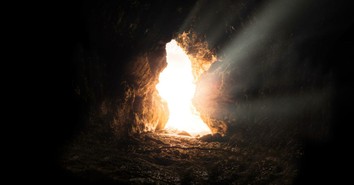
The book of Revelation is either the most exciting or the most frustrating book of the Bible to read. It can be exciting when you’re looking at prophecy fulfilled or frustrating when you’re confused about what is literal, what is symbolic, what is future and what is past. It can also be the most divisive book of the Bible because of differing views on interpretation.
Yet John, the writer of the Revelation of Jesus Christ, said “Blessed is the one who reads aloud the words of this prophecy, and blessed are those who hear, and who keep what is written in it, for the time is near” (Revelation 1:3, ESV).
How can you be blessed or happy when reading Revelation? When you avoid the common mistakes most people make when reading it – mistakes that can lead to confusion, fear, inaccurate predictions, disillusionment, paranoia, or end-of-the-world hype. Here are 10 common mistakes people make when reading Revelation.
Photo credit: ©©Unsplash/Ben White
1. Failing to Start at the Beginning

1. Failing to Start at the Beginning
SLIDE 1 OF 10
When you read a story, would you start with the last chapter first? Yet this is what many people do when they read Revelation. They start at the back of the book, instead of starting at the beginning. The Bible is one book of 66 smaller books and the first part of the book (the Old Testament) sets the stage, introduces the characters, lays down the Law and provides the reasoning behind God’s judgment – and His deliverance – at the very end of the book. It’s common for readers of Revelation to ignore the cross references and not look at the context of the Old Testament passages that are quoted throughout Revelation. But there is a reason Revelation is filled with footnotes directing you to the beginning of the book – passages in Exodus, Deuteronomy, Isaiah, Jeremiah, Ezekiel, and Daniel, just to name a few.
As you read Revelation, ask yourself “Why is John quoting Deuteronomy 32:43 in Revelation 6:10 and 19:2 when he talks about avenging the blood of His servants? Why is Jeremiah 3:1 quoted when John talks of the Prostitute or Great Harlot of Revelation 17:5-6? By going back to the beginning of the book and looking up passages quoted from the Old Testament you can arrive at Scriptural answers, rather than conjecture, when it comes to questions like “Who is the Harlot?” and other hotly-debated points.
Photo credit: Unsplash.com
2. Forgetting the Original Audience

2. Forgetting the Original Audience
SLIDE 2 OF 10
We tend to read the book of Revelation as if it’s written to Christians of 21st Century America so we can know what our future holds. Yet, the Revelation of Jesus Christ was a letter written “to the seven churches that are in Asia” (Revelation 1:4) to provide for them comfort in the midst of the persecution they were enduring and to strengthen them, as well as give them hope for what was soon to come.
So, every time you see the word “you” in a narrative, you must realize that “you” is not literally you. This letter written from prison to persecuted Christians in the First Century and delivered through the Roman Postal System used veiled language, at times (Revelation 13:18), that its direct recipients would fully understand. So, be a history buff. Brush up on what was happening in the First Century and why these words would be a comfort to them and why certain codes would be significant to them and quit trying to put yourself into the picture. There is room for application of God’s Word after you have first looked at what the text says by its original author to its original audience. The basic model of hermeneutics is to first ask What does the text say? Secondly, ask What does it mean, in light of who it was written to and the time at which it was written? The third and final question to ask is What does this mean to me and how I should live? Application is important, but keep first things first. Remember to whom it was written and read it through the eyes of a First Century persecuted Christian.
Photo credit: ©Thinkstock
3. Misunderstanding the Term "Last Days"

3. Misunderstanding the Term "Last Days"
SLIDE 3 OF 10
Christians today read about the "last days" and they get excited. They think in terms of Jenkins/LaHaye novels and Hollywood movies and immediately think "last days of the earth." Again, if you start in the Old Testament, you will understand that most of the references to the “last days” – also referred to as “latter days” (KJV and NASB), and “days to come” (ESV, NIV and NASB) – are referring to the last days of the Old Covenant, not the last days of the world.
For example, in Acts 2:14-40, Peter starts his powerful sermon on the day the first Church was established by quoting Joel 2:28-32 in which he says “In the last days it shall be….” That wouldn’t exactly be a relevant sermon on Opening Day of the First Christian Church, if Peter was talking about the last days of the earth some 2,000 + years hence, would it? But when you realize that sermon is talking about the last days of the Old Covenant that God made with Israel, it suddenly makes sense that Peter would be letting the first Christians know that, indeed, the ending of the Old Covenant was finally upon them and the New Covenant was being ushered in. The New Covenant was with Jesus – the long-awaited Messiah – who had been killed and then raised from the dead and “God has made him both Lord and Christ, this Jesus whom you (remember the audience relevance?) crucified” (Acts 2:36). By the way, the term Old Testament and New Testament is another way of saying Old Covenant and New Covenant. Understand the meaning of the various uses of “last days” throughout the Bible and you’ll better understand Revelation.
Photo credit: Pexels.com
4. Comparing Scripture with Headlines, Tweets, or Traditions

4. Comparing Scripture with Headlines, Tweets, or Traditions
SLIDE 4 OF 10
If you read Revelation and compare it with headlines on the evening news or in social media, you will have a completely skewed idea about what the book is about. Likewise, if you read it with the latest apocalyptic movie in mind, or the images in your head from the Left Behind series of novels, you will be reading into it what isn’t there.
Don’t compare Scripture with headlines or movies or even long-held beliefs going back to what you heard in Sunday School as a child. Compare Scripture with Scripture (both Old and New Testament Scriptures) and you will discover what is actually Scripture and what is merely conjecture, tradition, or hype from current events.
Photo credit: ©Thinkstock
5. Taking the Symbolic as Literal

5. Taking the Symbolic as Literal
SLIDE 5 OF 10
Yes, you believe the Bible is literal. So do I. But certain portions of Revelation (and the Bible, for that matter) are meant to be symbolic, not literal. When John says “I saw a star fallen from heaven to earth, and he was given the key to the shaft of the bottomless pit” (Revelation 9:1) he obviously is not talking about a literal star falling from heaven and being handed a set of keys. That is a symbolic reference to Satan from Ezekiel 28.
Likewise, when John says in Revelation 9:16-17 that 200 million horsemen with heads like lions and fire and smoke and sulfur coming out of their mouths will line up in the Valley of Megiddo to kill a third of mankind, this is also symbolic of a massive battle but most likely not a literal 200 million horse-mounted demon-like soldiers akin to the machines in Terminator or Transformers! Know the difference between narrative, which is to be read literally, and portions of prophesy and apocalyptic language, which is to be read symbolically.
Photo credit: Unsplash.com
6. Taking the Literal as Symbolic

6. Taking the Literal as Symbolic
SLIDE 6 OF 10
You’re right, this process goes both ways. Some phrases are meant to be symbolic and not taken literally and some of the prophesy is meant to be read literally and not symbolically. For instance, the churches in Asia that John is writing to in Revelation 1:4 are seven real churches that existed at the time the letter was written. That doesn't mean it was written to the seven “ages” of the church through the past two thousand years. Nor does it mean it was written to and about the seven “types” of churches or the different conditions of the church that exist in America or around the world today. While practical application can be made from the condition of the seven churches (such as the lukewarm Laodiceans), don’t make the mistake of making something literal completely symbolic.
Another example of this is in terms of numbers. When Revelation refers to a “thousand-year reign” is that a literal 1,000 years or is it symbolic of a very long time? Likewise, when John says the time is near (Revelation 1:3), and the events he has described “must soon take place” (Revelation 22:6), is that literally near and soon or symbolic for a distant date in the future? Know the difference between literal and symbolic and simile and metaphor when you read Revelation.
Photo credit: ©Thinkstock
7. Ignoring the Time References

7. Ignoring the Time References
SLIDE 7 OF 10
This also becomes a literal vs. symbolic question. But it is significant that there are more than 100 time statements in the New Testament. Do you know the different Greek words/phrases used for “time” in each of these references? It takes research to demonstrate the differences and when you compare Scripture with Scripture, you will find that they progressively become more imminent the closer you get to the Book of Revelation. Since the letter was written to the First Century Church undergoing persecution, and they are being told the events are “near” and Jesus is quoted as saying “I am coming soon” (Revelation 20:20), there is an undeniable sense of imminence.
Again, in reading the time references, refer to the Old Testament cross references. For instance, in Daniel 8:26, the Prophet Daniel is told to “seal up the vision, for it refers to many days from now” and in Daniel 12:4 he is again told “shut up the words and seal the book, until the time of the end.” Daniel was to seal his prophecy because it wouldn’t come about for another 400-600 years. Yet in Revelation 22:10, John is told “Do not seal up the words of the prophecy of this book, for the time is near.” Did God think 400-600 years for Daniel was further away than 2,000-plus years for John? Or does “near” actually mean “near” and “far” actually mean “far”? The Bible doesn’t contradict itself, so that problem can be solved through a proper understanding of time references.
Photo credit: Unsplash
8. Not Understanding "Apocalyptic Language"

8. Not Understanding "Apocalyptic Language"
SLIDE 8 OF 10
Throughout the Bible “apocalyptic language” is used to describe the devastation of God’s wrath and judgment against his enemies. In Second Samuel 22, after God spared David’s life from the hand of King Saul, David penned a song about how “the earth reeled and rocked; the foundations of the heavens trembled and quaked, because (God) was angry. Smoke went up from his nostrils, and devouring fire from his mouth; glowing coals flamed forth from him” (verses 8-9). David is describing God as a fire-breathing dragon who “parted the heavens and came down” (verse 10) and laid bare the foundations of the world at the blast of breath from his nostrils (verse 16). But that is poetic imagery to describe God’s might and power, not a description of God as a literal dragon levelling the earth.
The same type of language is used by John, particularly in Revelation 6:12-14 when he says “The sun turned black like sackcloth made of goat hair, the whole moon turned blood red, and the stars in the sky fell to earth, as figs drop from a fig tree when shaken by a strong wind. The heavens receded like a scroll being rolled up, and every mountain and island was removed from its place.” John was using apocalyptic language similar to Jesus’ words in Matthew 24 when He was describing God’s judgment. This type of language is foreign to us, which can cause us to look at Revelation and expect literal events from the apocalyptic language. But the First Century Jews understood this language because they were familiar with the Old Testament Scriptures.
Photo credit: ©Thinkstock/SanneBerg
9. Trying to Put "America" into the Scriptures

9. Trying to Put "America" into the Scriptures
SLIDE 9 OF 10
If you’re like me, you might have grown up looking at the Bible egocentrically, believing we (and this country) are at the core of everything God is doing. That type of approach to Scripture causes us to scour Revelation to find out where America fits into all of it and that can cause people to inaccurately – and repeatedly -- predict the “next date” the rapture will happen, and attribute national storms and disasters to fulfilled apocalyptic prophecy. But the United States wasn’t around when John wrote this vision to the First Century churches. So, you’re not going to find your President, your political party, or your country in the Book of Revelation. Taking into account audience relevance, it would’ve been meaningless to the First Century church for John to tell them what would happen a couple thousand years hence to all of us here in the USA. So, don’t waste your time trying to find out which president or world leader is “the Anti-Christ”– a term not even used in Revelation, but according to 1 John 4:3 is a spirit of rejection of Christ and was “in the world already” at the time John wrote the Book of Revelation.
We so want to believe we are “in the mix” and we will see these events in our lifetime that we convince ourselves we’re in there somewhere. In doing so, we fail to see Christ in the book and the vision of His glory.
Photo credit: ©Thinkstock
10. Forgetting it is a Vision of Christ, Not a 'Topic of Debate'

10. Forgetting it is a Vision of Christ, Not a 'Topic of Debate'
SLIDE 10 OF 10
Imagine having a dream or vision so vivid, so inexplicably glorious that you have a difficult time describing it in detail to others. John’s vision of the Revelation of Jesus Christ was something unlike anything he’d ever seen or imagined. He was no doubt at a loss for words in how to describe the glorified Christ’s presence as evidenced in phrases like “His eyes were like a flame of fire, his feet were like burnished bronze, refined in a furnace, and his voice was like the roar of many waters” (Revelation 1: 14-15, emphasis added). John was given a peek into the spiritual realm to see what no man has seen before. Thus, in his limited vocabulary and human existence, he did his best, with the inspiration of God, to give us a glimpse of heaven.
If you don’t fully understand the Book of Revelation, you’re certainly not alone. Its interpretation has been debated by Bible scholars for centuries. But rather than allow it to become a book of divisiveness, ask the Holy Spirit for His guidance as you look at Scripture and read the book for what it is – a book of worship and the Revelation of Jesus Christ – rather than a book of argument or debate. Whether you find yourself an amillenialist, premillennialist, or post-millenialist, and whether or not you subscribe to the pre-trib, mid-trib or post-trib view, make sure what you believe is grounded in what Scripture says, not what everyone else is saying or guessing.
Photo credit: ©Thinkstock/jdwphotos
Originally published September 22, 2023.







